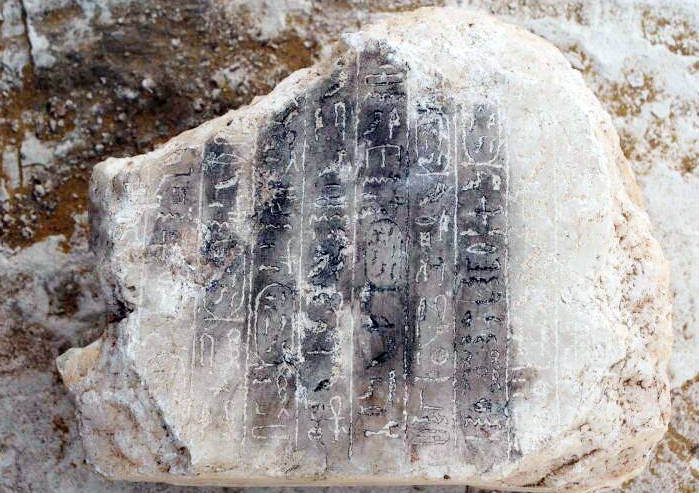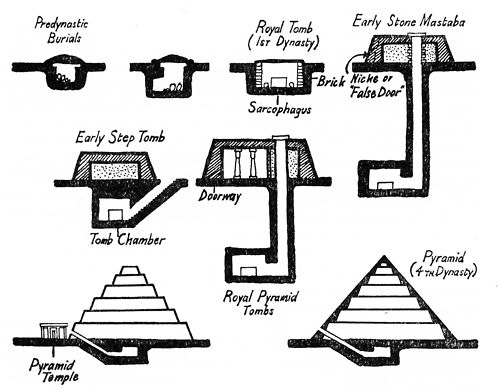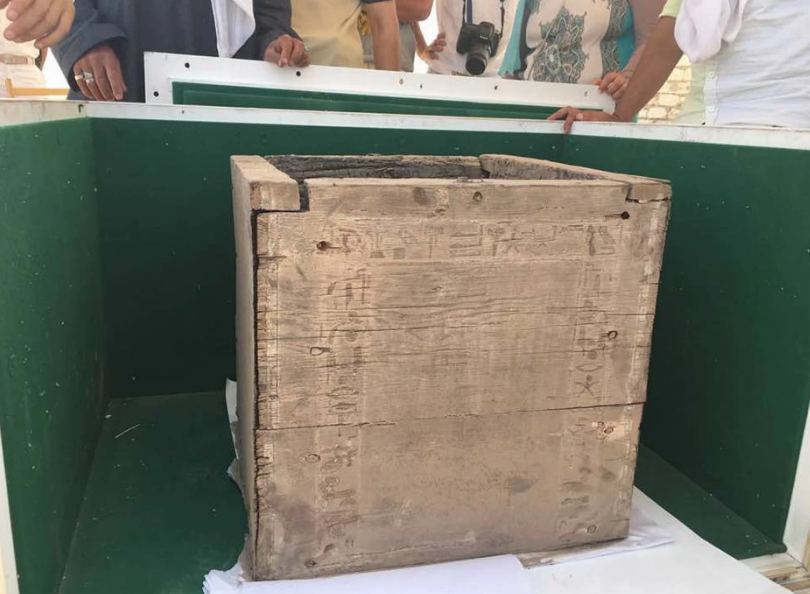It looks like you're using an Ad Blocker.
Please white-list or disable AboveTopSecret.com in your ad-blocking tool.
Thank you.
Some features of ATS will be disabled while you continue to use an ad-blocker.
14
share:
Burial Chamber of Princess Possibly Found in Ancient Egypt Pyramid
By Owen Jarus, Live Science Contributor | May 11, 2017 11:03am ET
755 77 MORE
Partner Series
Burial Chamber of Princess Possibly Found in Ancient Egypt Pyramid
Archaeologists have reached the burial chamber of the 3,800-year-old pyramid discovering the remains of a poorly preserved sarcophagus and a wooden box inscribed with three lines of hieroglyphs.
Credit: Courtesy of Egyptian Ministry of Antiquities
Inside a 3,800-year-old pyramid at the site of Dahshur in Egypt, archaeologists have discovered a burial chamber that may have held the mummy of a princess named Hatshepset. A wooden box inscribed with hieroglyphs was also found within the chamber.
The discoveries provide clues that may help archaeologists determine why a pharaoh named Ameny Qemau has two pyramids at Dahshur.
The wooden box is inscribed with "Hatshepset," which likely does not refer to the pharaoh Hatshepsut but rather someone else with a similar name, the researchers said. Last month, another inscription, written on an alabaster block, was also found in the pyramid. That inscription bears the name of pharaoh Ameny Qemau (also spelled Qemaw), who ruled Egypt for a brief period around 1790 B.C. It's the second pyramid that has an inscription bearing the name Ameny Qemau that is known from Dahshur. The other Ameny Qemau pyramid was discovered in 1957 and is located nearly 2,000 feet (about 600 meters) away from the recently discovered pyramid.
Source
There are a number of other sources on this... when you run across the ones where the pharaoh's name is spelled "Emnikamaw" - those are badly written and contain a number of errors.
A photo of the canopic box was shown to James Allen, right now (arguably) the greatest scholar of hieroglyphs in the world, who quickly translated them.
Live Science showed a photo of the inscriptions to James Allen, an Egyptology professor at Brown University, and he deciphered them. "It's a box for canopic jars. The inscriptions are typical for such boxes in the Second Intermediate Period [which lasted from about 1640 B.C. to 1540 B.C.] and belong on the side [of the box] facing east," Allen wrote in an email. The top line reads, "Neith, extend your arms over the Duamutef who is in you," according to Allen."
... the photo that I see isn't that high quality, but it's good enough to say "I agree." (I'm nowhere NEAR the scholar that Allen is!)
This may be the same woman named Hatshepsut who was the daughter of an officer (not to be confused with Hatshepsut, Queen of Egypt) mentioned on a stele and on a scarab (hieroglyph transcriptions and photos)
An excellent article from Luxor Times with some beautiful photos of the excavation can be found at this link
And yes, she was buried in a pyramid. Quite a few people have been found buried in pyramids. It's not an intrusive burial (people coming along later
and shoving a dead body in a pyramid); it's an original burial.
originally posted by: Byrd
And yes, she was buried in a pyramid. Quite a few people have been found buried in pyramids. It's not an intrusive burial (people coming along later and shoving a dead body in a pyramid); it's an original burial.
When you say "Pyramid" I'm guessing you really mean "Mastabas" - not the same thing though. The whole "mastabas are proto-pyramids" argument is a stretch to say the least. People have been found buried in Mastabas (that's what they were for), but I'm pretty sure (I may be wrong here...) that no corpse has ever been found buried inside an Egyptian pyramid that wasn't a Mastaba.
-MM
edit on 13-5-2017 by MerkabaMeditation because: (no reason given)
edit on 13-5-2017 by MerkabaMeditation because: (no
reason given)
This engraving looks totally fake; how come the engravings look fresh and white while the rock is burned and full of marks. The engravings don't fit
with the rest of the rock; looks newer. Probably something the archelogists added to fit their theories - not the first time, the guy who discovered
the Khufu pyramid wrote a paper that Khufu built it before he entered it and also discovered _the only_ cartush in the pyramid which conveniently said
"Khufu" - that's to much of a coincident for me to buy it, he obviously added the cartush himself.

I smell something fishy here...
-MM

I smell something fishy here...
-MM
edit on 13-5-2017 by MerkabaMeditation because: (no reason given)
originally posted by: MerkabaMeditation
originally posted by: Byrd
And yes, she was buried in a pyramid. Quite a few people have been found buried in pyramids. It's not an intrusive burial (people coming along later and shoving a dead body in a pyramid); it's an original burial.
When you say "Pyramid" I'm guessing you really mean "Mastabas" - not the same thing though. The whole "mastabas are proto-pyramids" argument is a stretch to say the least. People have been found buried in Mastabas (that's what they were for), but I'm pretty sure (I may be wrong here...) that no corpse has ever been found buried inside an Egyptian pyramid that wasn't a Mastaba.
-MM
No, she's buried in a pyramid. Not a mastaba.
There are well over 100 pyramids in Egypt, dating from the Old Kingdom (about 200 years before Giza) through the New Kingdom (a period of almost 2,000 years. They were relatively uncommon after the end of the Old Kingdom (around 300 years after Giza) but were revived as a practice later on. Many of the later ones were built out of mud brick, and until New Kingdom and Ptolemaic times only royals were buried in pyramids. Thereafter you find small pyramids over the graves of nobles.
originally posted by: MerkabaMeditation
This engraving looks totally fake; how come the engravings look fresh and white while the rock is burned and full of marks. The engravings don't fit with the rest of the rock; looks newer. Probably something the archelogists added to fit their theories - not the first time, the guy who discovered the Khufu pyramid wrote a paper that Khufu built it before he entered it and also discovered _the only_ cartush in the pyramid which conveniently said "Khufu" - that's to much of a coincident for me to buy it, he obviously added the cartush himself.
I smell something fishy here...
-MM
Something dark has been smeared on the surface to make the hieroglyphs visible - and they're actually pretty standard for the tombs of non-rulers. I can read something about a festival and see what appears to be a title "Daughter of" ...but can't read the cartouche.
The "full of marks" ... they're actually hieroglyphs. You're probably looking at the "t" and other small signs. The surface isn't very damaged, though that block has been partly destroyed (it was probably an interior wall of the tomb chamber.) Many of these structures were destroyed for their stone in more recent times... and some were found by excavation equipment when they were putting in roads and water lines and sewer lines and so forth.
In addition, she was a woman. Women seldom got the kind of attention to their burials that was given to high-status men. The contrast in quality between the royal husband's tomb and the wife's tomb can be rather startling, unless she was greatly beloved by the king.
If the only thing you look at are selected views of Giza and the interior of the Temple of Hathor at Dendera (this tends to make up about 90% of material posted on "alternate history" boards and websites) you're missing quite a bit. If you decide you'd later like to see what's out there (including things done by Napoleon's scientists for the first real survey of Egyptian antiquities), let me know and I'll put some links up.
edit on 13-5-2017 by Byrd because: (no reason given)
a reply to: Byrd
If you were a king, would you hire a geriatric stone mason with hand tremours to commemorate your life's great work on a stone stele? Just look at that poor quality of work, it does not look like it was made by a professional stone mason at all to me.
Are you really trying to convince me that these ugly wiggly lines

were made by the same people that made this piece of art:

Just look at the lines on the stele, they are not even close to straight - not very worthy of a great kings stele.
Conclusion, a modern fake I say.
-MM
If you were a king, would you hire a geriatric stone mason with hand tremours to commemorate your life's great work on a stone stele? Just look at that poor quality of work, it does not look like it was made by a professional stone mason at all to me.
Are you really trying to convince me that these ugly wiggly lines

were made by the same people that made this piece of art:

Just look at the lines on the stele, they are not even close to straight - not very worthy of a great kings stele.
Conclusion, a modern fake I say.
-MM
edit on 14-5-2017 by MerkabaMeditation because: (no reason given)
originally posted by: Byrd
originally posted by: MerkabaMeditation
originally posted by: Byrd
And yes, she was buried in a pyramid. Quite a few people have been found buried in pyramids. It's not an intrusive burial (people coming along later and shoving a dead body in a pyramid); it's an original burial.
When you say "Pyramid" I'm guessing you really mean "Mastabas" - not the same thing though. The whole "mastabas are proto-pyramids" argument is a stretch to say the least. People have been found buried in Mastabas (that's what they were for), but I'm pretty sure (I may be wrong here...) that no corpse has ever been found buried inside an Egyptian pyramid that wasn't a Mastaba.
-MM
No, she's buried in a pyramid. Not a mastaba.
There are well over 100 pyramids in Egypt, dating from the Old Kingdom (about 200 years before Giza) through the New Kingdom (a period of almost 2,000 years. They were relatively uncommon after the end of the Old Kingdom (around 300 years after Giza) but were revived as a practice later on. Many of the later ones were built out of mud brick, and until New Kingdom and Ptolemaic times only royals were buried in pyramids. Thereafter you find small pyramids over the graves of nobles.
I'm still think that your thinking about burial mastabas and not real pyramids, the line has been blurred by "scientists" so I don't blame you though. Pyramids were never burial chambers, but their purpose is sill unknown to us.
The picture below shows how "scientists" have tried to blur out the true purpose of the pyramids. Still today, if you visit the three pyramids at Giza in Egypt, the tourguides will tell you that they were burial chambers even though no mummy have ever been found in one of them.

-MM
edit on 14-5-2017 by MerkabaMeditation because: (no reason given)
new topics
-
Why isn't Psychiatry involved?
Social Issues and Civil Unrest: 3 hours ago -
Help in song interpretation
Music: 5 hours ago -
FEMA Head Admits Agency Skipped 20 Homes with Trump Signs
Mainstream News: 8 hours ago -
Yet another Hack...
Rant: 9 hours ago
top topics
-
Yet another Hack...
Rant: 9 hours ago, 12 flags -
FEMA Head Admits Agency Skipped 20 Homes with Trump Signs
Mainstream News: 8 hours ago, 12 flags -
U.S. Closes Kyiv Embassy Over ‘Significant Air Attack’ Intelligence
World War Three: 16 hours ago, 10 flags -
Gaetz ethics investigation results "hacked".
US Political Madness: 13 hours ago, 10 flags -
Help in song interpretation
Music: 5 hours ago, 1 flags -
Why isn't Psychiatry involved?
Social Issues and Civil Unrest: 3 hours ago, 0 flags
active topics
-
Post A Funny (T&C Friendly) Pic Part IV: The LOL awakens!
General Chit Chat • 7801 • : PorkChop96 -
Russia Ukraine Update Thread - part 3
World War Three • 6835 • : Oldcarpy2 -
U.S. Closes Kyiv Embassy Over ‘Significant Air Attack’ Intelligence
World War Three • 41 • : Imhere -
Well, here we go red lines crossed Biden gives the go ahead to use long range missiles
World War Three • 312 • : Oldcarpy2 -
Famous Catholic Exorcist Visits Mir-a-Lago
US Political Madness • 19 • : chr0naut -
-@TH3WH17ERABB17- -Q- ---TIME TO SHOW THE WORLD--- -Part- --44--
Dissecting Disinformation • 3331 • : brewtiger123 -
Why isn't Psychiatry involved?
Social Issues and Civil Unrest • 3 • : berbofthegreen -
Help in song interpretation
Music • 1 • : FullHeathen -
President-Elect DONALD TRUMP's 2nd-Term Administration Takes Shape.
Political Ideology • 226 • : WeMustCare -
FEMA Head Admits Agency Skipped 20 Homes with Trump Signs
Mainstream News • 10 • : BingoMcGoof
14

